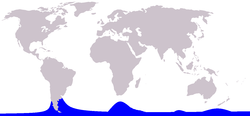Hourglass Dolphin
|
|
| Hourglass Dolphin Conservation status: Lower risk | ||||||||||||||||||
|---|---|---|---|---|---|---|---|---|---|---|---|---|---|---|---|---|---|---|
| Scientific classification | ||||||||||||||||||
| ||||||||||||||||||
| Binomial name | ||||||||||||||||||
| Lagenorhynchus cruciger (Quoy & Gaimard, 1824) | ||||||||||||||||||
 Hourglass Dolphin range |
The Hourglass Dolphin (Lagenorynchus cruciger) is a small dolphin found in Antarctic and sub-Antarctic waters.
The dolphin was for a long time rarely seen. It was first identified as a new species by Qouy and Galmard in 1824 from a drawing made in the South Pacific in 1820. It is only the cetacean to have been widely accepted as a species on eye accounts alone 1. Indeed by 1960, despite decades of whaling in the Southern Ocean, only three specimens had been brought to the attention of scientists. Even now only 6 complete and 14 partial specimens have been examined. Further information has been obtained from 4 strandings and boats which have deliberately set out to observe the dolphins in areas rarely otherwise visited by ships.
| Contents |
Physical description
The Hourglass Dolphin is coloured black and white and for this reason was colloquially known by whalers as the "sea skunk". On each flank there is a white patch at the front of the dolphin, above the beak, eye and flipper and a second patch at the rear. These two patches are connected by a thin strip of white, creating, loosely speaking, an hourglass shape and hence the common name of the dolphin. The scientific name cruciger is from the Latin for "cross-carrier". That the white patches are supposed to resemble both an hourglass and a cross is perhaps indicative of how inexact these descriptions are! The remainder of the body is black.
In its usual range the dolphin is easily identifiable. Only the Southern Right Whale Dolphin is of comparable size and found so far south. The Right Whale Dolphin doesn't have a dorsal fin and so the two species are trivially distinguished from one another. The fin varies from one individual to another quite considerably. Broadly speaking it is tall and curved, and the curve may be particularly pronounced in older animals.
A fully grown adult is about 1.8m in length and weighs 90-120kg. Females are probably slightly smaller and lighter than males (from a sample size of nine specimens).
Population and distribution
The range is circumpolar from close to the Antarctic ice pack to about 45°S. The most northerly confirmed sightings were 36°S in the South Atlantic Ocean and 33°S near Valparaiso, Chile in the Pacific. Sightings have been made most commonly from the south of New Zealand around the South Shetland Islands and off Tierra del Fuego, Argentina. The species is unlikely to be particularly densely populated close to these lands. One survey estimated that there was a minimum of 140,000 individuals alive today.
Behaviour
Hourglass Dolphins tend to move in groups of about 5-10 in number. One International Whaling Commission study recorded a group of 60. They share feeding grounds with other cetaceans such as Sei, Pilot, Bottlenose and Minke Whales and Southern Right Whale Dolphins. They are found very regularly with Fin Whales. In fact whalers hunting these much larger whales used to Hourglass Dolphins as "look-outs" to aid them in their hunt.
Hourglass Dolphins are keen bow-riders.
Examinations of the stomach contents of the few analysed specimens indicated the it eats various (unrecorded) types of squid and small fish.
Conservation
The Hourglass Dolphin is believed to be locally common. It has never been taken into captivity or deliberately hunted. The number of by-catches is very small. The effects of pollution on the dolphin is likely to be negligible given its distant distribution. The species is one of few cetaceans essentially unaffected by humans.
References
- National Audubon Society: Guide to Marine Mammals of the World ISBN 0375411410
- Encyclopedia of Marine Mammals ISBN 0125513402
Notes
- Species are normally identified from bodies of specimens killed deliberately for this purpose, or from individuals killed as a by-catch of other whales. Other species have been identified from washed-up skulls.de:Stundenglasdelfin
